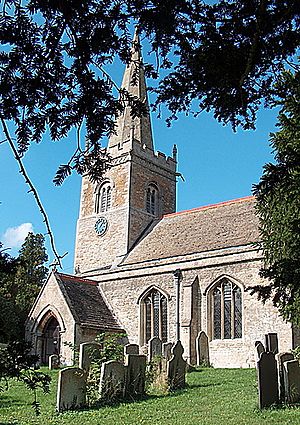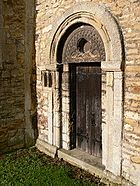St Medardus and St Gildardus Church, Little Bytham facts for kids
Quick facts for kids St Medardus and St Gildardus Church |
|
|---|---|

St Medardus and St Gildardus
|
|
| 52°45′02″N 0°30′03″W / 52.75056°N 0.50083°W | |
| Denomination | Church of England |
| History | |
| Dedication | SS Medard & Gildard |
| Administration | |
| Diocese | Lincoln |
| Province | Canterbury |
The Church of St Medardus and St Gildardus is a historic church in the village of Little Bytham, Lincolnshire, England. It is a Grade I listed building, which means it is considered very important to the nation's history.
This church has a very special name. It is dedicated to two French saints from the 6th century, St Medard and St Gildard. It is the only church in the entire United Kingdom named after them. While St Medard is not well-known in Britain, he is still famous in France. St Gildard is believed to have been his brother.
Every year, the village holds a celebration, or fête, around St Medard's special day, which is June 8th.
Contents
A Journey Through Time in Stone
The church is like a history book made of stone. Different parts of the building were built in different time periods, showing how styles changed over hundreds of years.
The Oldest Parts: Anglo-Saxon and Norman Times
The very first parts of the church were built by the Anglo-Saxons long ago. You can still see their work on the outside corners of the main part of the church, called the nave. They used a special technique with large stones called "long-and-short" work.
Later, after the Normans came to England, more parts were added in the Romanesque style. One of the most amazing features is the Priest's Door. It has detailed carvings, including a decorated half-circle space above the door called a tympanum.
The tympanum has an empty circle in the middle. Some people think it once held a relic, which is an important object from a saint. On either side of the circle are carvings of birds, which are probably eagles. One story says an eagle protected St Medard from the rain.
Gothic Additions from the 13th Century
In the 13th century, the church was expanded. The aisle on the south side and the upper parts of the tower and spire were built in the Gothic style.
The east window of the south aisle has a beautiful pattern called intersecting tracery, which shows it was built around the year 1300. Near this window is a piscina, a stone basin used by priests during services.
Another interesting feature from this time is a stone carving of a Green Man. This is a face surrounded by leaves, a popular design in old churches. This carving was once lost inside a wall but was found again during repair work.
Other Interesting Features
- The stone base of the pulpit, where the priest speaks, is from the year 1590. It has a Latin message carved on it: Orate et parate, which means "Pray and prepare."
- In the churchyard, there is a war grave for a soldier from the Royal Engineers who fought in the First World War.


